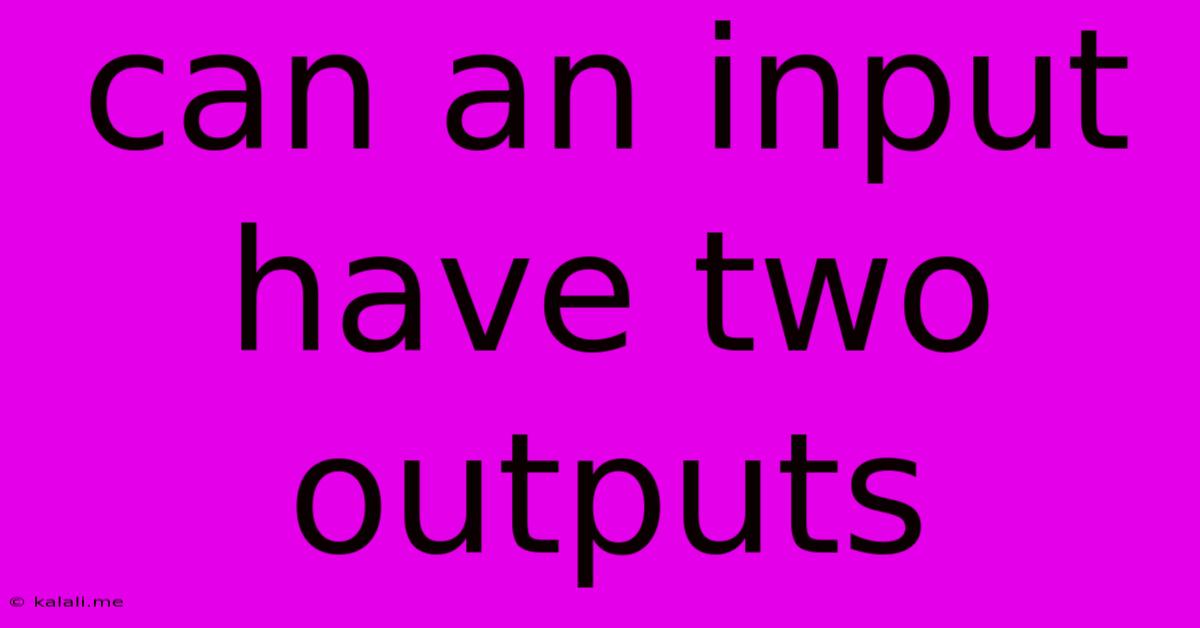Can An Input Have Two Outputs
Kalali
Jun 01, 2025 · 3 min read

Table of Contents
Can an Input Have Two Outputs? Understanding the Fundamentals of Functions and Systems
This article explores the question: can a single input have two outputs? The answer depends heavily on the context. In the realm of pure mathematics, specifically functions, the answer is generally no. However, in real-world systems and programming, the situation is more nuanced. Let's delve into the details.
Mathematical Functions: One Input, One Output
In mathematics, a function is defined as a relation between a set of inputs and a set of possible outputs with the property that each input is related to exactly one output. This is often expressed as a mapping: each input maps to one and only one output. This is crucial to the definition of a function. A single input cannot produce two distinct outputs; if it did, it would violate the fundamental principle of a well-defined function. Think of it like a vending machine: you input your money (input), and you get one specific item (output). You can't get two different items from the same selection.
Real-world Systems: The Nuances of Multiple Outputs
While mathematical functions adhere strictly to the one-input, one-output rule, real-world systems often exhibit more complex behavior. A single input can seemingly trigger multiple outputs due to several factors:
-
Branching Logic: Consider a simple program that checks a user's input. If the input is above a certain threshold, it might trigger two separate actions: sending an email and updating a database. While there's one input, the processing of that input leads to multiple outputs. This isn't a violation of functional principles because the underlying function might be viewed as mapping a single input to a tuple or set containing multiple outputs.
-
Randomness or Stochastic Processes: In systems involving randomness, the same input might yield different outputs. For example, simulating a coin flip with a program—the input might be "flip coin," but the output could be either "heads" or "tails," depending on the random number generator. The randomness is a key factor, not a violation of the function concept itself, provided the probability of each output is well defined.
-
System Complexity: Complex systems often have non-linear responses. A small change in input can sometimes result in dramatically different outputs. This isn't strictly "two outputs from one input" but highlights the limitations of simple input-output models when dealing with intricate systems.
Programming and Multi-valued Functions
In programming, functions can return multiple values. This is achieved through various techniques, such as returning arrays, tuples, or structures that contain multiple data elements. Again, it's not that a single input is producing multiple outputs in the strict mathematical sense, but rather that the output is a composite data structure.
Conclusion:
To summarize, a single input cannot produce two distinct outputs within the rigorous definition of a mathematical function. However, real-world systems and programming can simulate this behavior through branching logic, randomness, or by returning composite data structures as outputs. The key is to carefully consider the context and understand whether you're working with a purely mathematical function or a more complex system with multiple processing pathways. The apparent violation of the one-input, one-output rule often stems from the complexity of the system and how the outputs are represented, rather than a fundamental flaw in the concept of a function.
Latest Posts
Latest Posts
-
Toilet Filling Up But Not Flushing
Jun 03, 2025
-
How To Switch Text To Imessage
Jun 03, 2025
-
Work Out Your Salvation With Fear And Trembling Meaning
Jun 03, 2025
-
Extend Hieght Of Fence For Sun Sail
Jun 03, 2025
-
How Much Spinach In A Bunch
Jun 03, 2025
Related Post
Thank you for visiting our website which covers about Can An Input Have Two Outputs . We hope the information provided has been useful to you. Feel free to contact us if you have any questions or need further assistance. See you next time and don't miss to bookmark.